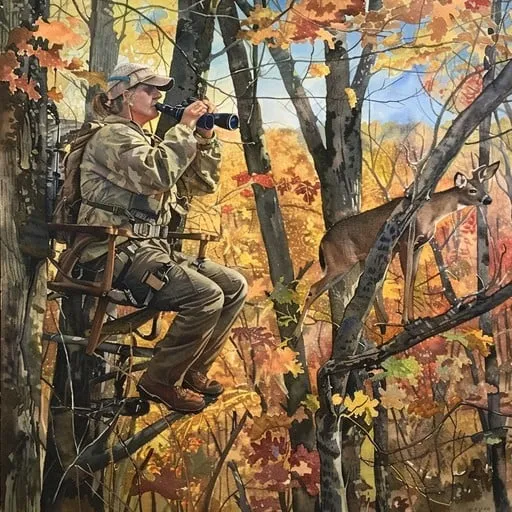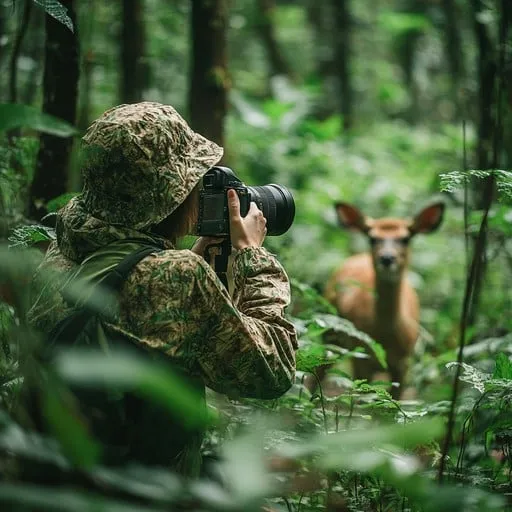20 Expert Deer Hunting Tips for a More Successful Season
In this article, we’ve compiled 20 proven deer hunting tips to help you sharpen your skills, avoid rookie mistakes, and make the most out of your next hunting season.
Whether you’re a seasoned hunter or a first-timer headed into the woods, deer hunting requires more than just patience and luck. It demands strategy, timing, and a deep understanding of deer behavior. The good news? With the right tips and preparation, you can dramatically improve your chances of a successful and ethical hunt.
1. Know the Regulations
Before stepping foot in the woods, always check your local hunting regulations:
- Is your license valid?
- Are you hunting in the right season and legal zone?
- What are the bag limits?
- What weapons are allowed (rifle, bow, muzzleloader)?
Fines and violations can be steep — and unintentional mistakes are still punishable.
2. Scout the Land Early
The most successful hunters scout weeks or months in advance. Look for:
- Bedding areas
- Feeding grounds (acorns, soybeans, corn)
- Water sources
- Rub lines and scrapes
Use trail cameras and satellite mapping apps like onX Hunt to track movement patterns.
3. Understand Deer Behavior
Learn how deer move based on time of day, pressure, and weather.
- Dawn & dusk are peak activity hours (crepuscular)
- Windy days = deer stay bedded
- Cold fronts = increased daytime movement
Understanding rut phases (pre-rut, peak rut, post-rut) can dramatically improve your shot opportunities.
4. Control Your Scent
Whitetail deer have a supernatural sense of smell. To stay hidden:
- Use scent-free soap & laundry detergent
- Store gear in airtight containers with leaves or earth scent wafers
- Always hunt with the wind in your face
- Consider ozone scent eliminators (like Ozonics)
5. Practice with Your Weapon
Whether you use a rifle, shotgun, or bow, practice regularly.
- Sight-in your rifle before every season
- Practice shots from elevated angles (like tree stands)
- Be comfortable shooting out to your ethical max range, not just ideal conditions.
6. Tree Stand or Ground Blind?
Both work — but knowing when and where to use each is key:
- Tree stands give better visibility but require more scent control
- Ground blinds offer concealment and comfort, ideal for youth or gun season
- Always use a safety harness with elevated stands
7. Be Early. Be Quiet. Be Still.

Arrive at least 30–60 minutes before legal shooting light.
- Walk in slowly, quietly
- Avoid snapping branches or loud gear
- Once settled, remain as still as possible — movement ruins more hunts than noise
8. Hunt the Same Spot Multiple Times? Maybe Not.
Deer pattern hunters as much as hunters pattern deer.
Too much pressure on one location can shut it down.
Rotate stands or switch to observation posts to reduce disturbance.
9. Hunt the Wind — Not Just the Forecast
Even if the forecast says a west wind, terrain can create swirling effects. Use wind checkers (powder, milkweed fluff) to detect how scent travels where you are.
10. Use Mock Scrapes & Deer Attractants
Scrapes are a key communication tool during the rut. You can:
- Create mock scrapes with a licking branch
- Apply doe-in-estrus scents
- Use scent drippers to keep bucks revisiting
Always follow local laws on attractant use — some states ban baiting or synthetic scents.
11. Call Smart: Grunt, Bleat, Rattle
- Grunt calls attract curious bucks or mimic rivals
- Bleats (especially doe-in-heat) during rut are powerful
- Rattling antlers can trigger territorial bucks — works best in pre-rut
Use sparingly. Overcalling makes deer wary if no scent or movement matches.
12. Follow Blood Trails Carefully
If you hit a deer:
- Wait 30–60 minutes before tracking (unless you saw it fall)
- Mark first blood spot and use a flashlight at night
- Look for bubbles (lung shot), green slime (gut shot), or steady drips (heart)
Never rush a track. Pushing a wounded deer can make recovery harder or impossible.
13. Learn from Every Hunt
Keep a hunting journal:
- Wind direction
- Time of movement
- Weather patterns
- Shots taken or passed
These small details build the knowledge that separates casual hunters from consistent ones.
14. Time Your Hunts Around the Moon & Rut
Some hunters swear by moon phase patterns — others prefer cold fronts and rut weeks. Track:
- New moons for mid-day activity
- Full moons for early and late movement
- Peak rut = most aggressive buck behavior
15. Know What Deer Are Eating
Food drives behavior. Pay attention to:
- Falling acorns in early season
- Agricultural fields (corn, soybeans)
- Browse during late season (brambles, buds)
- Use this knowledge to intercept feeding paths
16. Dress for the Weather — and Stillness
Sitting for hours means layering smart:
- Base: moisture-wicking
- Mid: insulation (wool, fleece)
- Outer: waterproof and windproof
Keep hands, feet, and head warm — cold toes end more hunts than bad aim.
17. Use Trail Cameras Wisely
Place trail cameras:
- Over scrapes, food plots, or trails
- At different angles to avoid night glare
- With date/time stamps to track movement trends
Pull cards at midday, not morning/evening, to avoid spooking deer.
18. Learn the Land Like a Local

Study:
- Topo maps for saddles, ridges, benches
- Aerial maps for funnels, edges, and transition zones
- Deer love edges — where woods meet field, thick brush meets hardwoods
19. Stay Mentally Silent
Don’t text too much. Don’t fidget. Don’t second-guess yourself constantly.
Trust your setup. Stay focused. Let the woods come alive — it always tells a story if you’re paying attention.
20. Respect the Hunt
Whether you tag out or go home empty-handed:
- Appreciate the process
- Honor the animal
- Share your knowledge
- Never stop learning
Hunting is about more than meat — it’s heritage, conservation, and connection with nature.
Final Thoughts About Deer Hunting
Every deer hunt is different. Some are quiet and uneventful. Others offer adrenaline-pumping moments you’ll never forget. But every time you enter the woods, you have the chance to learn, grow, and become a better hunter.
Follow these tips, respect the land, and stay ethical — and you’ll find that success in deer hunting goes far beyond the harvest.
Frequently Asked Questions (FAQ) About Deer Hunting
1. What is the best time of day to hunt deer?
The best times to hunt deer are early morning (just before sunrise) and late afternoon to dusk. These are the periods when deer are naturally most active, especially during the fall season and rut.
2. How does weather affect deer movement?
Cooler temperatures and cold fronts often lead to increased daytime deer movement. Windy or rainy conditions can reduce activity or cause deer to stay in cover longer. Snow can help track movements, but heavy snow may delay deer movement until later in the day.
3. How important is wind direction when deer hunting?
Very important. Deer rely heavily on their sense of smell. Always position yourself downwind of likely deer travel routes or bedding areas. Use wind-checkers or milkweed to monitor real-time scent direction.
4. What is a mock scrape and should I use one?
A mock scrape is a man-made deer communication spot, often created under a low-hanging branch and sprayed with doe or buck scent. They are especially useful during pre-rut and rut, attracting dominant bucks checking for competition or mates.
5. What are the signs of a good deer hunting location?
Look for:
- Fresh tracks and droppings
- Rubs (tree bark stripped by antlers)
- Scrapes on the ground
- Nearby food sources, water, and bedding cover
- Natural funnels or pinch points (where terrain guides deer)
6. What gear do I absolutely need for deer hunting?
At minimum, you need:
- A legal weapon (rifle, bow, etc.)
- Ammunition or arrows
- Valid hunting license and tags
- Camouflage or weather-appropriate clothing
- Knife, flashlight, and safety harness (if using a stand)
Optional but helpful: rangefinder, scent control spray, calls, trail cameras.
7. Are trail cameras worth using for deer hunting?
Yes. Trail cameras help track deer patterns, timing, and herd size. They also reduce the need for physical scouting, minimizing human scent in the area.
8. What’s the best way to practice shooting for hunting season?
- Practice realistic distances (20–50 yards for bows, 50–200+ yards for rifles)
- Use 3D deer targets or shoot from elevated positions
- Practice in full hunting gear to simulate real conditions
- Focus on accuracy over distance
9. Is it better to hunt from a tree stand or a ground blind?
Both are effective.
- Tree stands offer better visibility and scent control but require climbing and safety precautions.
- Ground blinds are safer and better in bad weather, especially for youth or first-time hunters.
10. How do I make sure my deer hunting is ethical and legal?
- Know your local regulations (season dates, bag limits, legal weapons)
- Practice quick, humane shots
- Never take risky shots just to “get lucky”
- Always recover and respect the animal
- Don’t trespass or bait illegally
About the Author – Ana Milojevik

Ana Milojevik is a seasoned outdoor writer, passionate hunter, and advocate for ethical wildlife practices. With over a decade of hands-on hunting experience across diverse terrains, Ana specializes in whitetail deer behavior, sustainable hunting strategies, and field craft.
Her deep understanding of scouting, gear selection, and seasonal patterns makes her a trusted voice among new and experienced hunters alike. Whether she’s tracking sign in the woods or sharing practical tips through her writing, Ana brings unmatched insight and clarity to the art of the hunt.
When she’s not in the field or behind the keyboard, Ana enjoys mentoring young hunters and contributing to conservation efforts that protect our hunting heritage for future generations.